I tried 21 diet and exercise programs. None of them worked. Except for one.
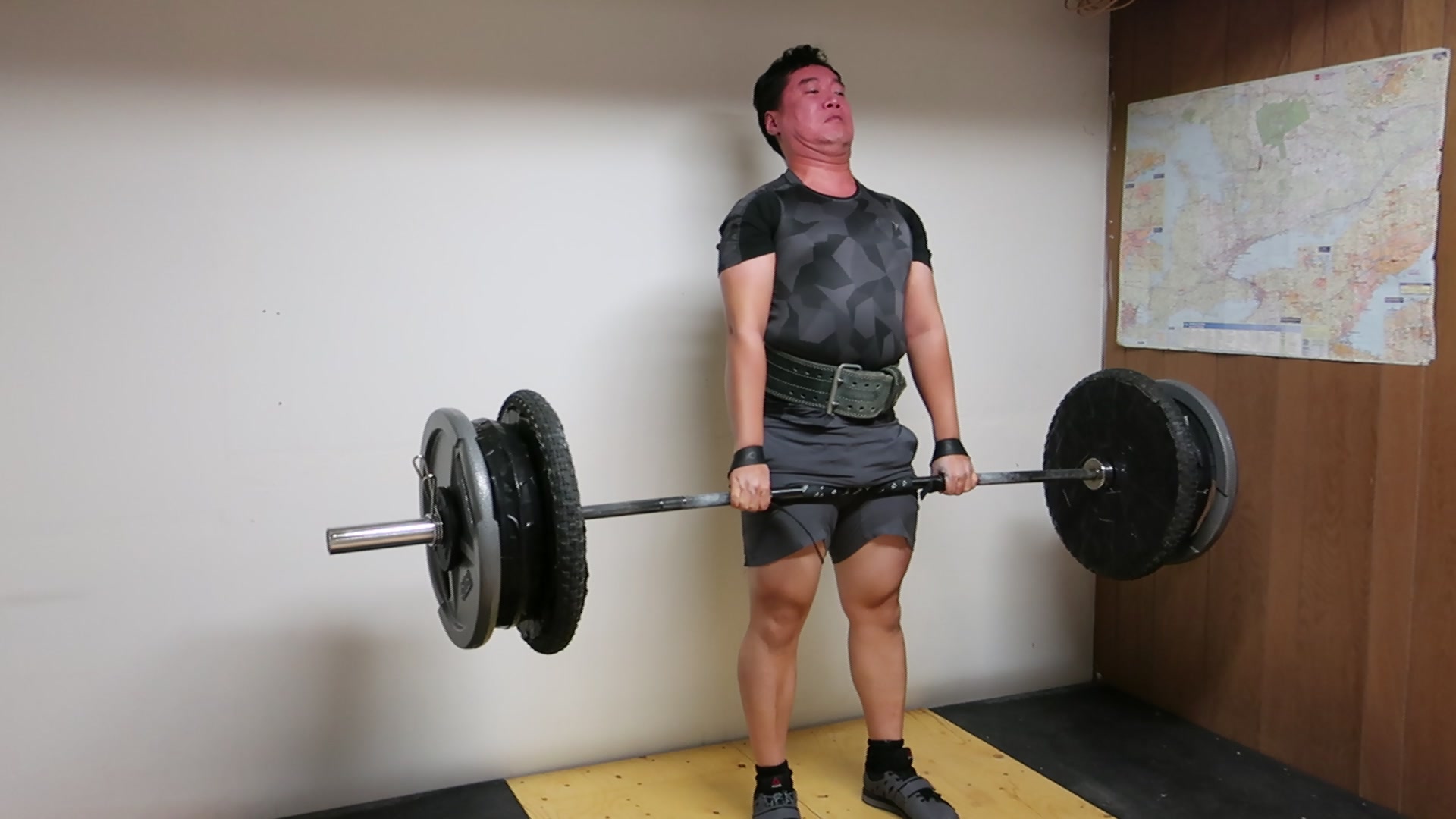
Deadlifting 337.5 lbs in my home gym.
I wasted years failing at improving my health and fitness by following misguided “common sense” advice. I tried everything: P90X, cross-country running, bodybuilding, HIIT, swimming, BodBot, 2 types of yoga, CrossFit, rowing, personal training, F45, and cycling. None of them worked.
It seemed like everyone around me was getting results, but no matter how hard I tried, I wasn’t able to carry more things, attain a muscular physique, better outrun an emergency, or climb over a fence.
But after hundreds of hours of frustration and disappointment, I finally figured out what was preventing me from achieving the fitness results that I wanted.
I made 10 major mistakes by following “common sense” advice that hindered my progress for years. They are:
- Not reasoning from first principles
- Taking action instead of planning
- Not planning all the way until the end
- Doing exercise instead of training
- Listening to experts
- Following a plan not designed for me
- Not wanting results
- Not gathering information
- Using nutrition instead of mindfulness
- Not prioritizing recovery
Mistake #1: Not reasoning from first principles
Who
I learned that everyone’s body is different. A nutrition and exercise program that works for me may not work for you, or vice-versa. Our genetics, physiology, and lifestyles are not the same so do not read this article as “advice” for you. It is advice only for me.
For example, I use more extreme language than other articles on health and fitness, because I find it necessary to go “all or nothing” in forming habits, but this writing style may be counterproductive if it does not fit your predilection; e.g. I’ll say something like “If you miss a workout, you have to start over from the beginning”, and this is not technically true because you can make up for the workout later, but I need to be told that the stakes are much higher than they actually are to motivate myself to stay on track. I regret that nobody was ever this forceful with me. By being too forgiving they gave me an excuse to not take things as seriously as I should have. You may find this writing style off-putting, but I will remind you that this is written for me, not for you.
One way I wasted a lot of time in the beginning is assuming that other peoples’ advice can apply to me, but it can’t. What worked was to figure out what first principles apply to my situation, and then build up a strategy from there to solve my individual needs, and not copy or follow someone else’s advice from the Internet.
Why
Why are health and fitness important? Physical health is required to operate in the physical universe. It’s the wellspring from which all other actions depend. Therefore, to improve your cognition, mood, relationships, career, morals—work out.
How
Ground truth comes from physics. The irreducible first step is Force = Mass × Acceleration. This is an inviolable law of the universe. Force production is therefore the only objective performance metric. All other secondary goals (weight loss, flexibility, cardiovascular health, etc.) are therefore relevant only when they are on the critical path to improving force production.1
Maintaining health is expensive, and biological organisms do not spend more resources than marginally required by their environments, because any wasteful organism will be evolutionarily outcompeted by a more resource-conserving rival. Therefore, any increase in wellness must be proportional to a preceding increase in stress. This leads us to the second step, the Stress Recovery Adaptation cycle (SRA), which I will describe later. Any strategy that does not follow this is disallowed by biology.
Mistake #2: Taking action instead of planning
It’s important not to overthink things—just take action! You’ll figure it out as you go.
No plan survives contact with the enemy.
Just Do It.
These are all wrong. It turns out that planning is really, really important. I did not expect this, but having an appropriate plan makes or breaks your success.
Based on what I learned from entrepreneurship and the “Lean Startup Approach”, I assumed that a mediocre plan with great execution is better than a great plan with poor execution. This is not true for health and fitness.
A mediocre plan with great execution is not better than a great plan with poor execution. A mediocre plan with great execution achieves nothing.
Good planning is the difference between achieving all your goals, and achieving nothing at all. Action is irrelevant to outcome.
The problem with bad plans is that taking the wrong action gives you negative progress. “Just Do It” is harmful advice, because it gives you the illusion of progress while actually accomplishing nothing, or taking you in reverse.2
It took years for me to learn this because the vast majority of exercise programs are not good. It was only by luck that after years of trying many different programs I finally found one that worked. The probability that the average personal trainer you pick after walking into a random commercial gym can design the right program is effectively nil.
To understand why planning is more important than action, I have to explain four other mistakes:
- Mistake #3: Not planning all the way until the end
- Mistake #4: Doing exercise instead of training
- Mistake #5: Listening to experts
- Mistake #6: Following a plan not designed for me
Mistake #3: Not planning all the way until the end
Strenuous exercise is not required for success in modern civilization. Thus, the vast majority of people lack any adaptation to physical stress, with the result that even a tiny amount of exercise will produce results. This gives the misleading impression that exercise is “easy” because almost anything you do in the beginning will work; but “doing anything” eventually causes you to stall out very quickly when the early progress ends, you get frustrated, and then you quit.
From Practical Programming for Strength Training:
Virtually anything that makes a novice work harder than bed rest will produce positive results. As a result, many people have an erroneous impression of the quality of their training system. Single sets, multiple sets, high volume, high intensity, super slow, supersets, giant sets, gnarlmonster sets – quite literally anything resembling a training program will produce better results than no program at all in novice trainees. This is known as “the novice effect,” and must be considered when training this population.
This is what happened to me: I tried cross-country running which worked for a bit until it didn’t, then I got discouraged and quit. Then I tried P90X which also worked for a bit until it didn’t, then I got frustrated and quit. And so on ad infinitum.
After I understood the novice effect, I could see that the key to a successful fitness program is not about how effective it is for beginners, but about how effective it is for people at all skill levels from beginner to olympian.
Mistake #4: Doing exercise instead of training
Exercise is about physical activity. Almost any strenuous physical action you take can be classified as exercise, no matter if it is helpful or harmful in the long term.3
Training is about long-term goal-directed progress. It requires that you set an objective, measurable goal you can achieve (e.g. deadlift 200lbs, run 1 mile in under 20 minutes, finish 1st in my city’s tennis tournament). If an external observer cannot unambiguously say whether you succeeded or failed at your goal4, then you also cannot tell whether your day-to-day actions are beneficial or harmful to your long-term goal, hence this is not training.5
The reason for this distinction is the biological first-principle that determines whether you will succeed or fail in the long-term: the Stress Recovery Adaptation cycle.
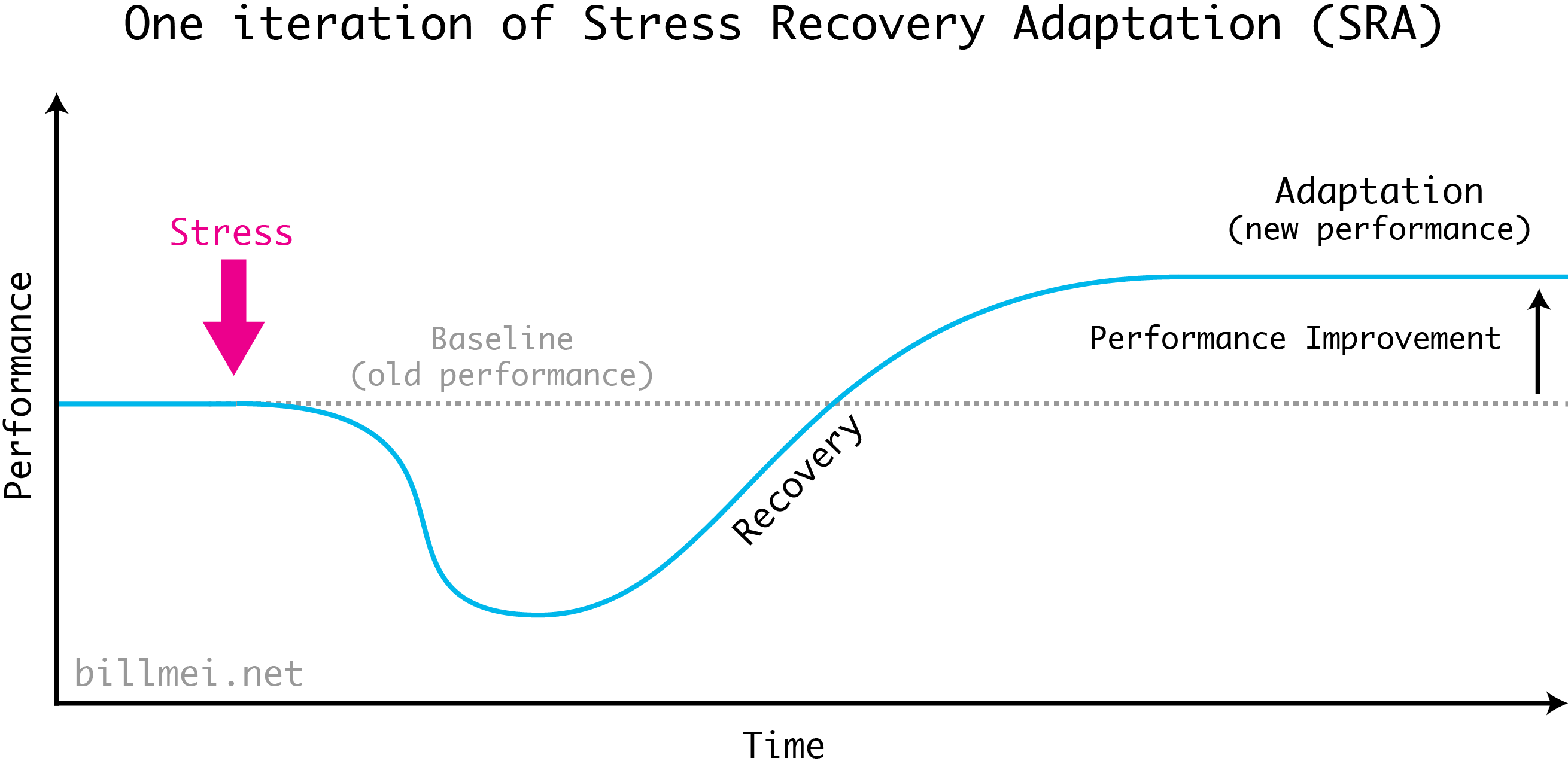
x and y axes exaggerated for emphasis in all of these graphs.
Performing exercise creates stress on the body, which diminishes your biological capabilities for a short time. As you eat and sleep, your body repairs itself during recovery, plus some additional extra capacity (adaptation) to handle future stress.
The stress is an external signal to your body that your environment must be more dangerous than it previously assumed, so your body tries to adapt to enable you to have a better chance of staying alive going forward.
Doing a workout that isn’t any harder than what you did before does not lead to additional adaptation, because you didn’t signal to your body that your environment is more dangerous than it previously assumed:
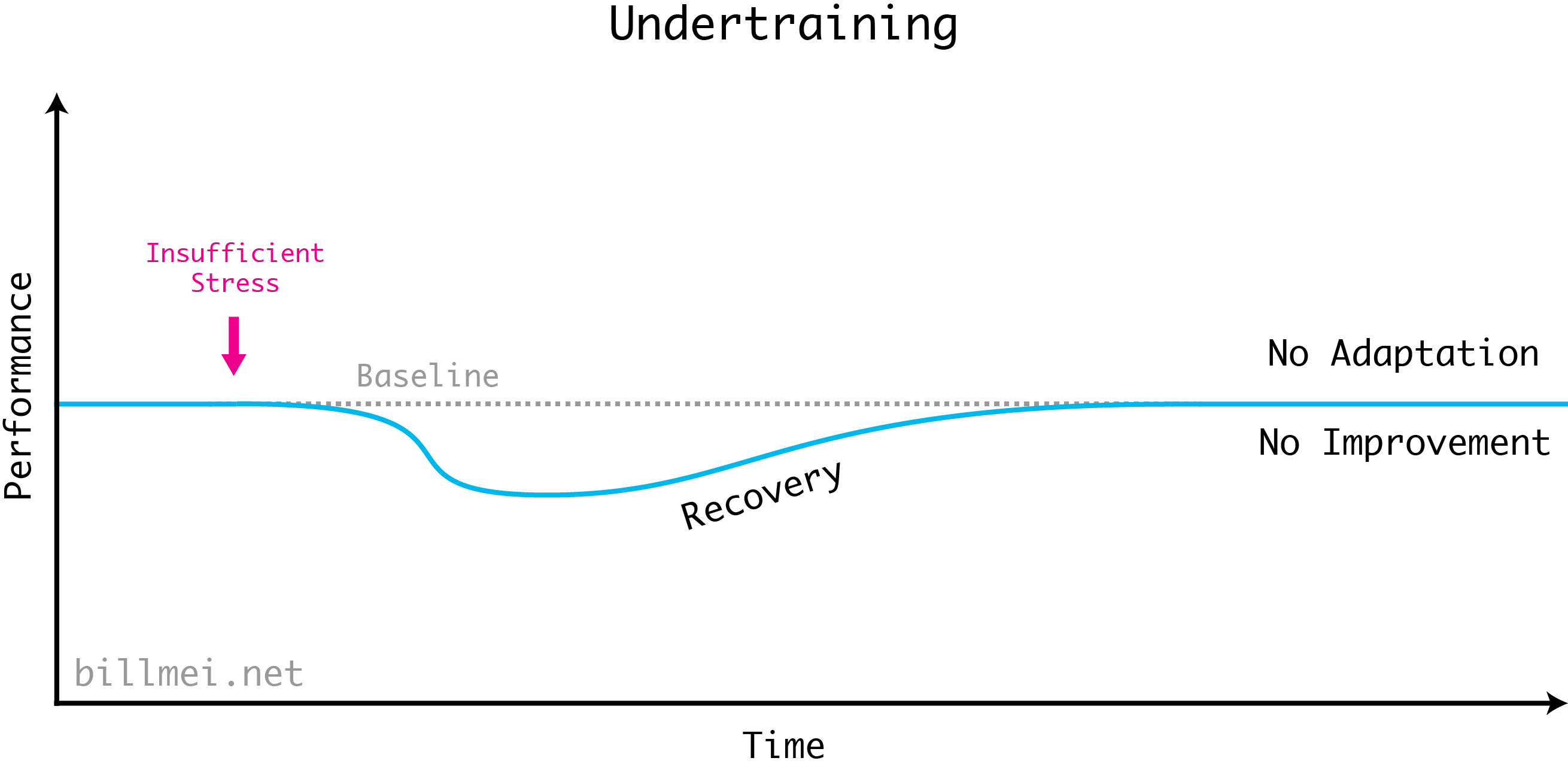
Biological organisms do not spend more resources than marginally required by their environments, because any wasteful organism will be evolutionarily outcompeted by a more resource-conserving rival. Thus, a lack of stress is a signal to your body that your environment must be safer than it previously assumed, so your body tries to conserve resources by decreasing its athletic capability:
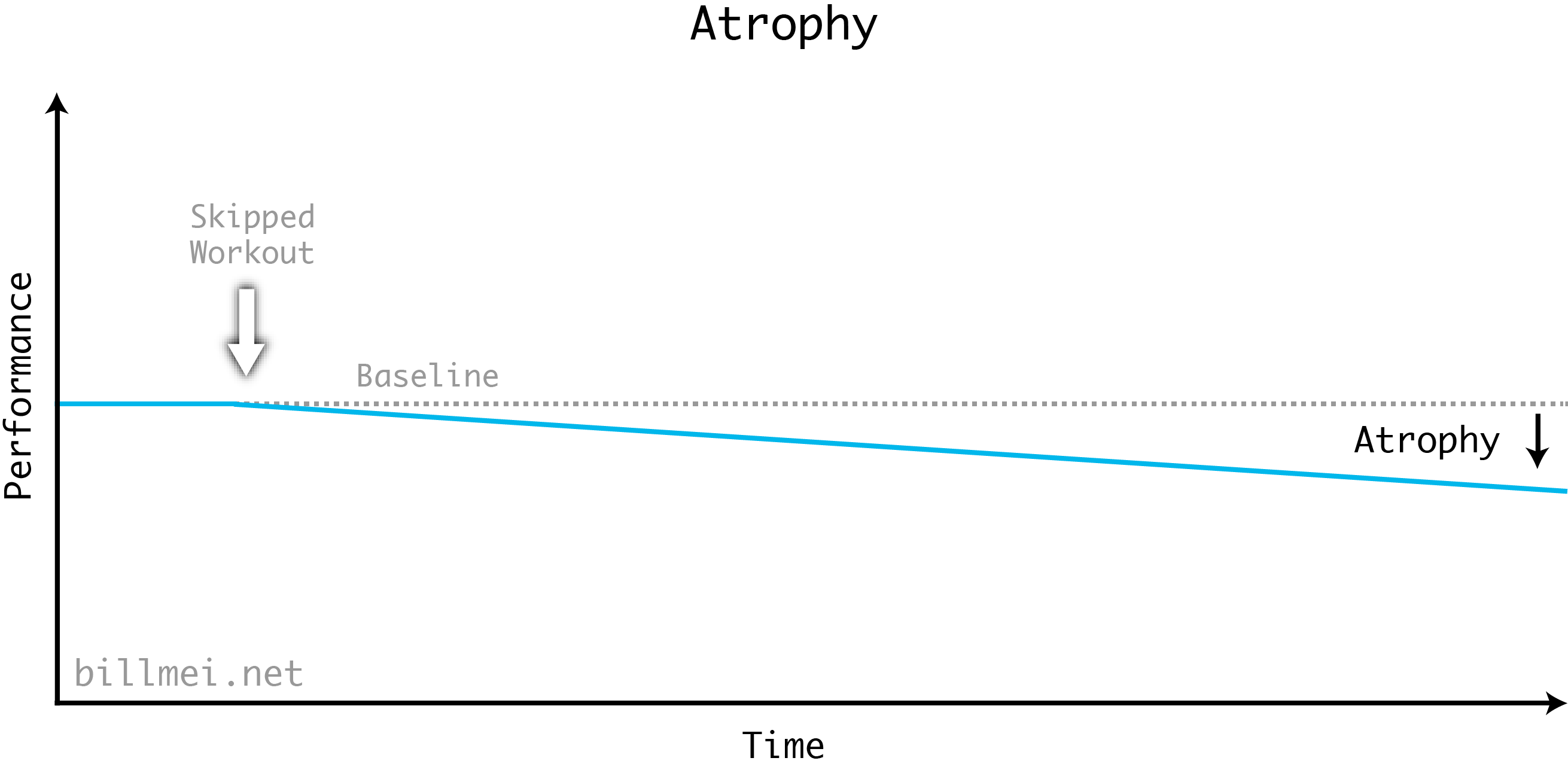
Conversely, too much stress that exceeds your body’s ability to recover will just result in your cells breaking down without being properly repaired:

Thus, the key to effective training is to carefully tune the amount of stress per exercise into the “Goldilocks zone” where you receive just enough stress to trigger an adaptation response, but not too much stress that you can’t recover, and not too little stress where you don’t trigger any adaptation response.
If you repeat this over a long time horizon, you get this classic (but incorrect!) graph that everyone draws, which you’ll see if you google this topic:
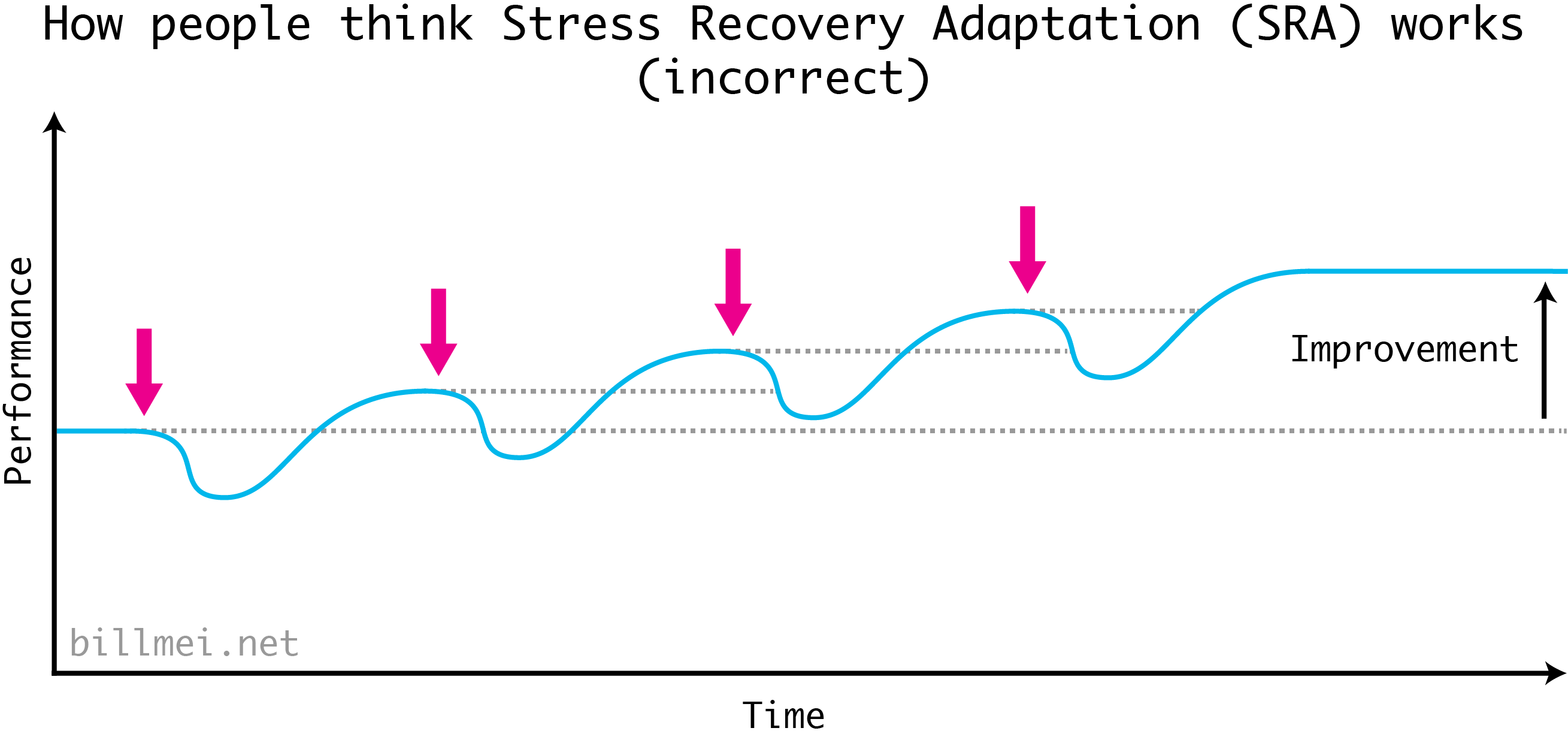
There is a key mistake made by everyone else who draws this graph. The big problem with the above diagram is that once you’ve adapted to a higher baseline, a larger amount of stress is required to trigger further adaptation!
Trying to exert the same stress on a higher baseline does not trigger adaptation, because your body has gotten used to it and the stress no longer signals that the environment is more dangerous than previously assumed. That’s what the word adaptation means!
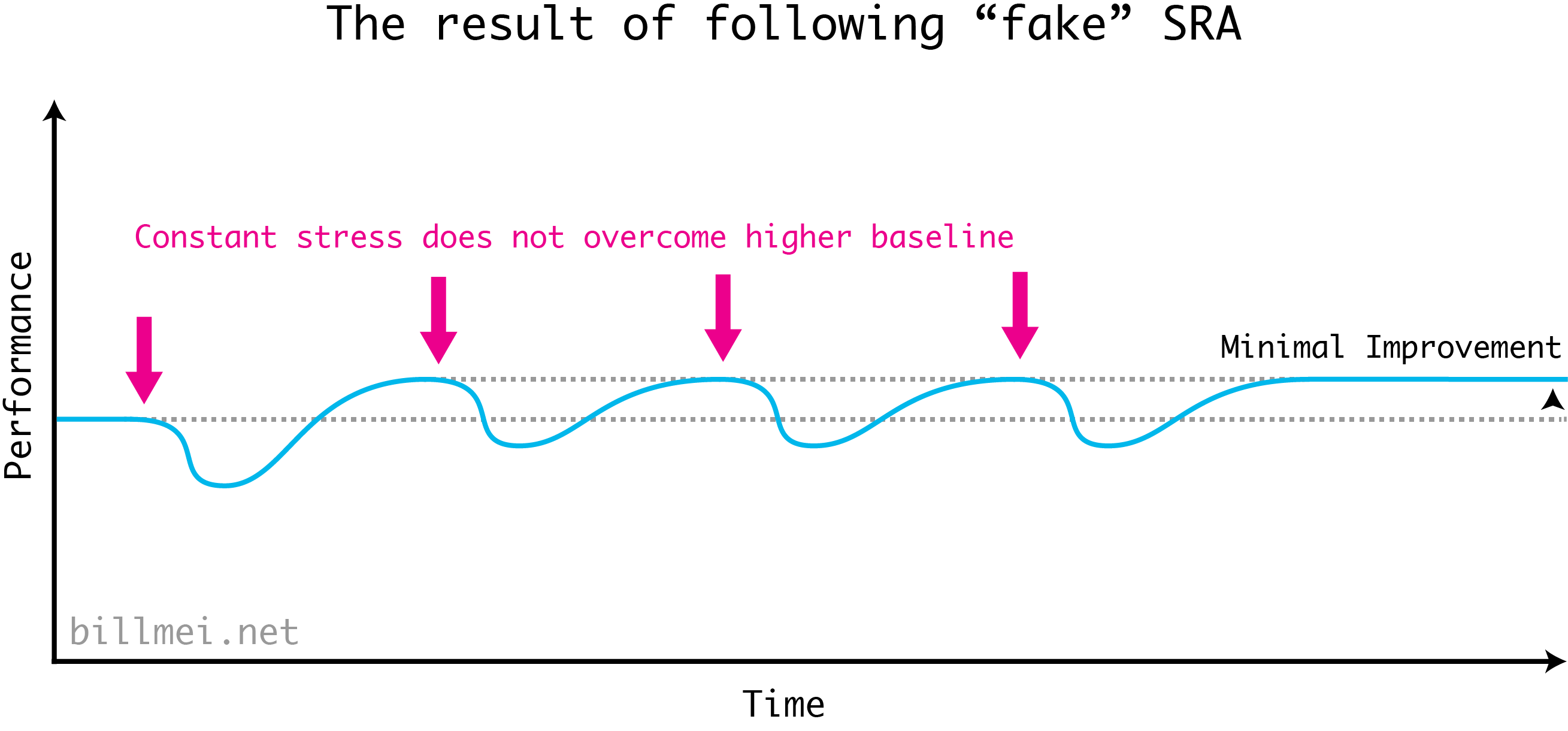
If you want to achieve increasing accumulated improvement, you have to apply more stress after the second workout than during the first workout. And then even more stress after that!
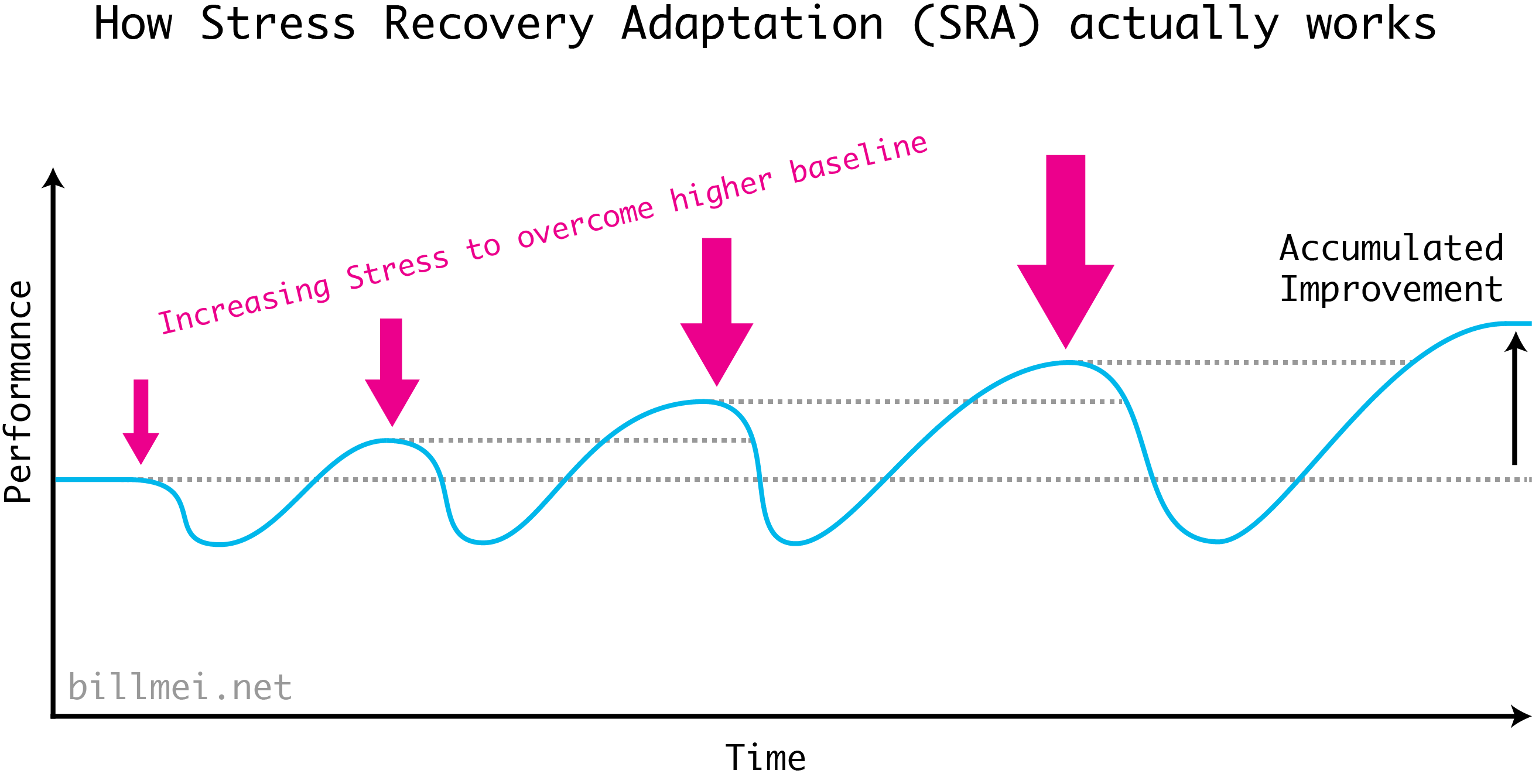
There are five things to note about the above diagram:
- Order matters. If we took the biggest stress and applied it during the first workout instead of the fourth workout, then it would have been overexertion that leads to a performance decline because our baseline was lower during the first workout than during the fourth workout.
- As stress increases, each decline in short-term performance is larger. But the adaptation increases by only a small constant amount, despite the larger drop. Our observed total improvement at the end is the result of the accumulation of these small incremental improvements, not any single big improvement.
- As stress increases, the time required to recover increases as well.
- Timing matters. If we skipped a workout, or worked out too soon before fully recovering, this would have lead to a performance decline.
- The novice effect means that we can achieve some improvement in the beginning, but if we do not plan all the way until the end, we would not be able to design a stressor of an appropriate size applied at the appropriate time to overcome a high baseline and achieve even higher adaptation.
This “real” SRA diagram shows why planning is more important than action. Because I followed the advice of “Just Do It” and basically just messed around at the gym, my results looked like this:
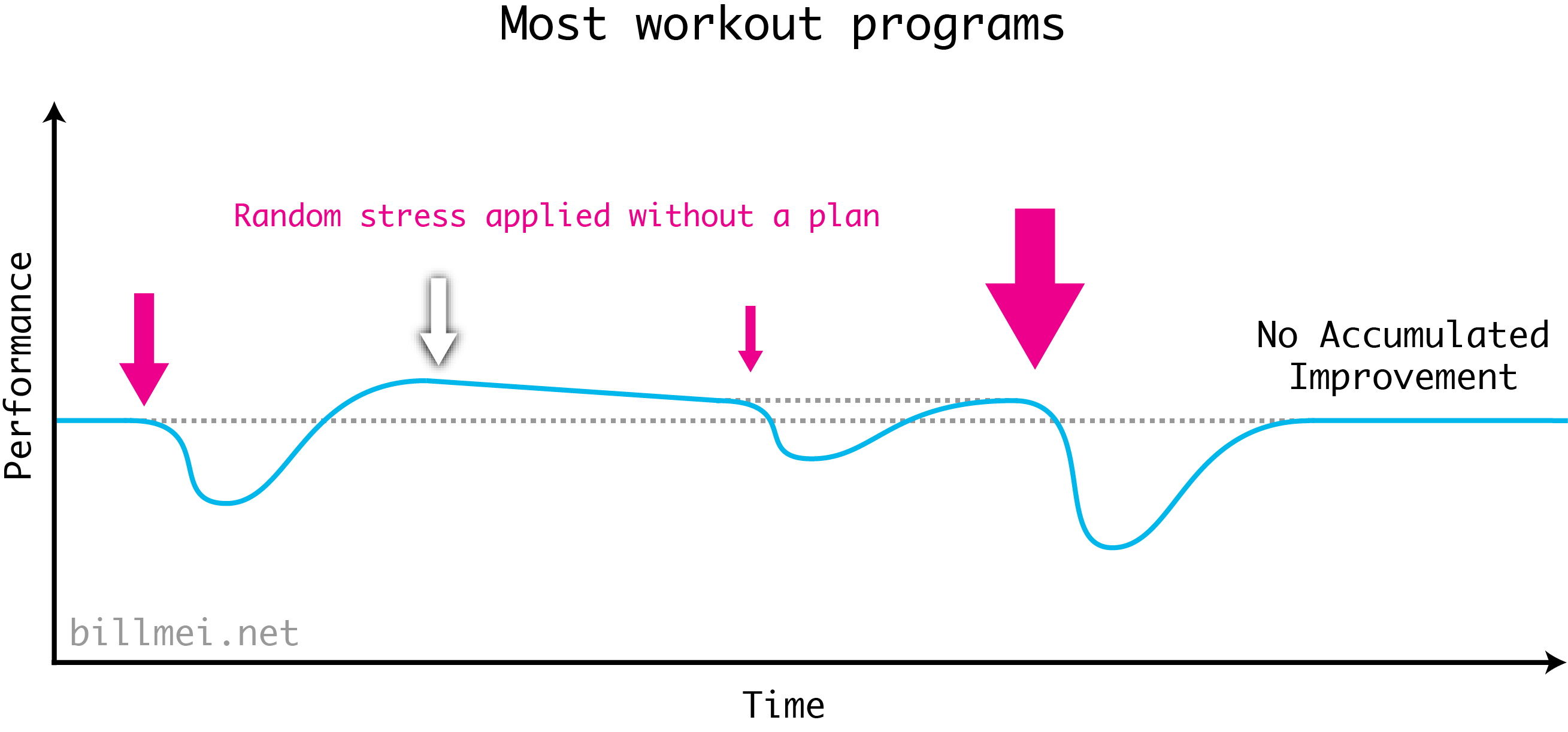
I had seen the “fake” SRA diagram numerous times over many years, but it never occurred to me how profound its conclusion was. I wish someone explicitly told me what I just told you, so I could have saved years of following ineffective programs.
In hindsight, I’m not surprised that I never understood the “real” SRA principle, because the doctors, trainers, and coaches I asked never mentioned it. In fact, it was probably a bad idea to even ask them for advice at all.
Mistake #5: Listening to experts
Doctors and personal trainers are educated by traditional medical schools, sports science labs, and certification boards. These traditional institutions gain their legitimacy from their application of the scientific method, and hence draw their evidence from empirical observation of randomized controlled trials. Most people defer their health and fitness advice to professionals because they feel that this foundation of validated knowledge qualifies them to give advice. Thus the phrase “ask your doctor”.
However, traditionally educated experts are generally not a good source of health and fitness advice. It’s not your doctor’s or your trainer’s fault, but the entire medical/health/fitness industry is systemically broken in how it understands athletic performance.
There is nothing wrong with the scientific method, indeed, it is the best way to discover new knowledge. The biggest problem with traditional institutions is not the scientific method itself, but with how scientists are paid.
Exercise science and sports science research focuses on pathological cases. Academic studies require funding, and committees don’t approve grants unless investigators can show that their research benefits a large population, or a vulnerable population.6
This is not a scientific issue, but a political one. Funding organizations receive their funds from taxpayers and wealthy donors, so it must produce research that benefits a large population (to appease the taxpayers), or a vulnerable population to elicit empathy and raise the status of its wealthy donors.7
Therefore, science-backed studies inherently focus only on average, older, obese, or unhealthy individuals trying not to die. It is not incentivized to research how average individuals can become exceptional, or how exceptional individuals can become even more exceptional.8
The reason this is unintuitive is that we hear all the time from public health professionals, “it doesn’t matter how you exercise, any exercise at all is good!”
Their goal is to prevent you from dying, not to help you achieve peak performance. It is noble to make sick people healthy, but because I already was a healthy person, this advice lead only to my disappointment.9
So if you are unhealthy and want to achieve average health, then yes, listen to your doctor.
But I did not want to be average. I wanted to be exceptional.
Mistake #6: Following a plan not designed for me
Before I figured this out, the first handful of personal trainers I hired designed programs that were completely inappropriate for me.
Why did this happen? It’s not a conspiracy. It’s just that nobody in the fitness industry is incentivized to help you.
Personal trainers make money when they can keep you dependent on them, not when they deliver results. The quicker they can get you results, the less money they make. The first trainer I hired put together an advanced program with so much complexity that it was futile for me to figure out the program for myself; it isn’t profitable to teach the fundamentals, because it’s boring and hard to drum up demand for it.
We looked across the gym and saw someone performing lateral raises with dumbbells while standing on a Bosu ball. (This is an exercise that focuses on smaller muscles in the shoulder and doesn’t do much for the rest of the body.)
My coach watched for a moment and then said, “Imagine how good you have to be for that exercise to be the thing that gets you to the next level.”
— Stop Wasting Time on the Details and Commit to the Fundamentals
One time I talked to a gym owner who proudly boasted about how he teaches his staff to psychologically manipulate clients into sharing their anxieties so the coaches could press the client’s insecurities until they relented in spending thousands of dollars on premium memberships.
Indeed, the business model of an average commercial gym is to make sure you sign an expensive contract and then stay away from it as much as possible. If you do unfortunately show up at the gym, they make sure to fill most of the floor space with weight machines and treadmills as far as the eye can see, but have only a single squat rack, because they don’t want to accidentally encourage you to show up more often by teaching you more skills and lifting techniques.
Similarly, it’s unlikely that following the advice of a celebrity, professional athlete, or blue-checkmarked Instagram account will lead you to an effective workout program.
Celebrities need their audiences to like them, or else lose access to lucrative sponsorship deals, so they try to promote things that pander to as wide of a population as possible, not to you individually.
Remember this graph?

If you follow a workout plan you saw from an “influencer”, it is unlikely that the amount of stress generated is appropriate for your physiology, at this time, for your goals, as their pronouncements are directed toward their masses of followers, not you.
Being a professional athlete is also not a guarantee that their advice is appropriate for you, because you cannot just copy what they are doing. They’re professionals, so they’re likely farther along in the SRA cycle than you are, so copying them will just result in inappropriately large amounts of stress that you can’t adapt to because you don’t have million-dollar sponsorships paying for a team of doctors who are optimizing your recovery.
My training effectiveness improved drastically once I understood that it’s important to figure out my personal strengths and weaknesses as an athlete, and then only following advice for my specific situation. To do otherwise would simply lead to insufficient stress or overtraining.
Mistake #7: Not wanting results
How can you not want results? When most people say they “want results”, they don’t actually want objective, measurable results. What they want is to look like a magazine cover, become less insecure, attract a partner, or impress their friends. It’s okay to want these things, but these are neither objective nor measurable, so they do not count as “results”.10
The path to actual results means becoming less sexy, less confident, repelling romantic partners, and alienating your friends. Actual success requires what feels like stepping backward, and defining “results” as “social approval” means you may succeed at approval, but you won’t succeed at objective goals.11
Before I started working out, I had the mistaken belief that self-confidence was internal. That I had to just “fake it until I make it”, and simply believing in myself was the only thing necessary for self-confidence. I found that this was not the case. Does a winner need to look in the mirror and recite affirmations of how cool and awesome they are? No. The best way to feel like a winner is to win. Once I started winning, I started feeling like a winner, and the self-confidence took care of itself. Then, the best path to gaining both internal and external approval is to pick a strategy that helps you win as much as possible as quickly as possible.
A side-effect of this is that “motivation” is not required. Results create their own motivation. Before I formed an effective plan, I would constantly be looking for motivational quotes, affirmations, and trying to amp myself up by listening to motivational speakers on YouTube. But after I followed an effective plan and started seeing results, I stopped doing this because I didn’t need it anymore, as the benefits of athletic training became directly and immediately apparent.
A lack of motivation revealed an ineffective program, or a flawed strategy that was unable to deliver results, rather than any psychological flaw I had.
Do you need “motivation” or “habit design” to abuse opioids? To become a workaholic for money? No, because these things are highly dangerous addictive substances. A lot of psychology talks about motivation, environment design, habits, etc. I shouldn’t have tried to create a “habit” or find “motivation”. What I needed is to get myself addicted to fitness.
I needed to use all the same strategies the tobacco, opioid, and fast food industries use to get myself addicted to fitness as quickly and deeply as possible.
Everyone has specific weaknesses to addiction and your task here is to find out what yours is. Some people find comparing themselves to others empowering, others find it terrifying. My weakness was seeing numbers go up. Games like Cookie Clicker are highly addicting even though the game is literally only about making numbers go up. Strength training has this aspect, and I found the “add more weight every workout” aspect the most personally psychologically compelling.
The result of focusing on quick wins meant that I went from barely being able to do a pushup to bench pressing my own bodyweight in a little over a month. Keeping a journal and recording my workouts was the best thing I have ever done to keep myself motivated, and it was as easy as allowing the numbers to speak for themselves.
Mistake #8: Not gathering information
If more information was the answer, then we’d all be billionaires with perfect abs.
Turns out this was wrong. I actually did need more information.
I think most people, deep down, just want someone else to whip them into shape without doing any work themselves. Hence, a lot of common advice is about how to build good habits, gain motivation, and gather discipline. But this didn’t work for me; I found out that I needed to gather information, not discipline.
Whether due to the extensive mathematical and logical training in my formative years, or for some other reason, I discovered that I am part of a minority of people who find contradictions intolerable in a way that most other people don’t.12
It took me a long time to realize that unlike me, most other people were ok with hypocrisy. While you may indeed feel that hypocrisy is bad, you probably don’t feel it with such visceral intenseness that it completely overtakes your hypothalamus. Hypocrisy makes me uncomfortable in a way that holding a screaming baby would make you uncomfortable. Regardless of what you’re currently doing, you’ll ignore everything else to make the screaming stop, no matter how hard you need to work.13
So the more I learned about nutrition and exercise, the more intolerable it became that I wasn’t working out and eating healthily. The more I learned about the SRA cycle, the more I realized how damaging it is to skip a workout, so I stopped skipping workouts.
I realized that without information, I lacked a model of how exercise “works”, and didn’t understand what “good” looks like. Most fitness advice just tells you what to do, not why to do it. If I understood the “right” thing to do, then I could debug my own failings and self-correct.
Thus, by voraciously reading dozens of books about health and fitness, interviewing dozens of trainers until I found a good one, and practicing for hundreds of hours at the gym, I finally built up enough of a model of how athletic performance works that I could subsume it into my identity, rendering the need for motivation or discipline obsolete.
Mistake #9: Using nutrition instead of mindfulness
I tried the atkins diet, going vegan, whole 30, the paleo diet, a juice cleanse, the elimination diet, a low carb diet, the slow carb diet, and the keto diet. I even spent a month carrying around a scale to weigh all my food and meticulously bookkeep every calorie. None of these worked for weight loss.
Only two things worked: intermittent fasting, and mindfulness.
Intermittent fasting wasn’t very complicated, and I had only one simple rule. If I needed to lose weight, I made sure to always to go bed hungry each night. If I needed to gain weight, I made sure to always go to bed full each night.
For me, mindfulness meant paying attention to how I feel after eating, and then only eating things that make me feel good, while avoiding things that make me feel worse.
I discovered that I get sleepy/moody/sluggish/more depressed after eating simple carbohydrates, so I cut down on simple carbs. Milk makes me feel bloated and queasy, so I stopped drinking milk. Salad makes me feel good, and I become more relaxed and clear-headed, so I eat more salad.
The key to “mindfulness” was to ask myself why, deep down, I really wanted to eat. Was it because I was bored? Thirsty? Procrastinating? Feeling socially awkward and needing to occupy my hands with something from the snack table? By paying attention to my inner monologue, I could prevent these passing non-hunger based reasons to eat from taking over my actions if I just let the thoughts continue without attaching to them.
I wrote more about this technique here: Healthy habits require courage, not sacrifice
The mindfulness-based approach helped me fortify the association between good foods and good feelings, as well as bad foods and bad feelings, which helped me build a visceral pull towards good foods and push away from bad foods, which doesn’t require willpower or reasoning myself into behaving a certain way.
I wrote another blog post about an additional technique that helped for weight loss. For more details, see: Build a bigger engine, not a smaller fuel tank.
Mistake #10: Not prioritizing recovery
I’m still working on this one. Remember when I said that pursuing results may cause you to lose friends? It turns out that maintaining a consistent sleep schedule makes your social calendar less flexible. Not only that, but the siren song of the Internet is just too strong sometimes, and I think an increasingly important part of health and fitness will be identifying and avoiding technologically enhanced addictions. But that is an essay for another time.
Conclusion
Putting together all of the above, I found the most effective approach for me is to follow the Starting Strength philosophy. You can read more about why in this article about Stronglifts, which is a slightly different program, but has the same principles.
The fundamental idea behind both programs is the concept of Linear Progression14. Other workout programs may be about having fun, making friends, or getting sweaty, but Linear Progression is about optimizing the SRA cycle directly to achieve objective results as quickly as possible.
Everything else I tried, including P90X, cross-country running, bodybuilding, HIIT, swimming, yoga, CrossFit, rowing, cycling, and more, violated some or all of the above principles, ignored the biological reality of the SRA cycle, and were not systematic strategies for getting fit, so I failed to meet any goals. This lack of clear results demotivated and discouraged me, which made the program even less effective, and so on.
Linear Progression is the only strategy I found that was designed from first principles to be maximally effective for me, and although I’m embarrassed that it took so long for me to figure this out, I’m proud to have made significant progress with it, taking me from barely being able to squat my own bodyweight to being able to squat 300+lbs today.
Even though I wrote this article as advice for me, not for you, I hope it reveals some lessons that you may not have encountered elsewhere, and helps you in your health and fitness journey as well.
I only publish half of my writing publicly. You can read the rest of my essays on my private email list:
Subscribing is free, no spam ever, and you can safely unsubscribe anytime
Recommended Resources
This article is advice for me, not for you, but if you want advice for you here are the top books and articles I recommend from authors that actually understand health and fitness from first principles, and not from the misconceived traps that I described.
Listed by recommended reading order.
-
James Clear’s guides:
-
Design A Workout Routine Read from beginning to end.
- Diet Plan from the same author, not as good but short so you can skim it.
-
The Primal Blueprint More general overview. Can skim, I don’t endorse everything in there.
-
Practical Programming for Strength Training Chapters 1-6 are critical. Chapter 7 and onwards you can return to once you are more experienced.
- While Starting Strength is more popular, I think it is too technical for those just starting out. Practical Programming is more beginner-friendly.
-
The Slow Carb Diet 4 Hour Body is a mediocre book, the Slow Carb Diet is the only part worth highlighting in my opinion.
-
Either Food Rules (more prescriptive) or In Defense of Food (more scientific)
Optional extra books for nerds:
- Becoming a Supple Leopard More advanced, read only after you’ve finished the other books.
- The Mind-Gut Connection Very sciency.
- Why We Sleep Awesome and also very sciency.
Footnotes
-
See Strength and its Derivatives for why. ↩
-
How can taking action be harmful? If you fail as the result of taking the wrong action, this simply reinforces your self-image as a failure, and adds evidence to your identity of “I’m not an athletic person”. I am arguing here that failure is foreordained under some lines of action (i.e. those that do not follow SRA), so it is best to avoid taking action until you can plan all the way to success.
The victorious strategist only seeks battle after the victory has been won, whereas he who is destined to defeat first fights and afterwards looks for victory.
— Sun Tzu
-
Further reading: The Biggest Training Fallacy of All ↩
-
Examples of goals where failure is impossible: “I want to look better in the mirror”, “I want to feel good about my body”, or “I want to lose weight” (without specifying a target weight and a deadline). You cannot “train” towards these goals, under the definition we’re using here. ↩
-
A corollary is that if you want to hire a personal trainer, a signal that they know what they are doing is they provide you clear, objective, external goals, instead of saying nonsense like they will “help you feel more confident in your own clothes”, and also accept a deadline where you agree to fire them if they do not help you achieve your goals by that date. Bad trainers may feel awkward accepting this because they are not used to accountability for their results. ↩
-
From Practical Programming for Strength Training:
Why do four-year colleges and universities, whose job it is to graduate students with bachelor’s degrees in PE and who at the same time must support a faculty of masters degree candidates and PhD professors, fail to study a phenomenon that necessarily takes place over a time frame of many years within a highly motivated group of competitive athletes that will not be accessible to The Department for use as study subjects and who will not alter their training to suit the needs of a study that compares different training methods over time?
The answer is obvious: They can’t. Studies that might effectively investigate and compare actual training methods for athletes cannot be designed and conducted within the limitations of the university system of study. The Department has access to undergraduate students to serve as test subjects, virtually all of whom would be considered novices and would show the Novice Effect in response to any training protocol, i.e. everything works, more or less. They also have access to populations of elderly people who have time to be study subjects. They do not usually have access to competitive athletes who can alter their training for a study designed by someone unfamiliar with their sport and its training requirements. Semesters last about three months. Publications requirements are annual. Masters degree candidates are in the The Department for 2-3 years. They must publish to complete, or publish at the whim of The Chairman, whose job it is to appear productive to The Administration. The people in charge of study design and methodology would necessarily have been personally exposed to properly-designed training programs before they could possibly be equipped to ask the right questions. Such people are in very short supply within PE departments, as odd as that seems. People in PE departments are trying to either graduate, acquire tenure, teach fewer sections, publish as much as possible, or retire. This may seem to be a harsh assessment, and it doesn’t mean that these people are evil. But the reality of the situation is that the vast majority of PE programs have no access to either the concept or the data of training, and cannot prepare their people to deal with it. […]
Exercise science has its problems. The populations it studies are typically small, often fewer than 20 people in the group. These people are very seldom trained athletes, and are most usually untrained college-age kids for whom any stress is adaptive. This makes for a poor way to study the effects of two different exercise methods, and completely precludes any questions regarding training. Often the methods themselves are poorly constructed, (doing a squat study on a Smith machine), completely omitting any quantification of the movement pattern being studied (precisely what is a squat? How deep is it? What is the hip angle? Does this affect muscle recruitment? How is this measured?), or display a failure on the part of the staff to standardize its interactions with the study population (“Try really really hard this time.”). Sometimes the study duration is too short to reveal anything meaningful about the question being investigated, since we are dealing with students in the study population that will only be available for one semester.
-
See “academia is primarily an institution for credentialling folks as intellectually impressive.”
Further reading: “grossly inadequate systems tend systematically to be unfixable by individual non-billionaires.”
What if there’s some intervention which could save 100 QALYs/$, yet produces neither great citations nor great prestige? Then if we add a few altruistic researchers to the model, they probably won’t be able to find a grantmaker to fund it; and if we add a few altruistic grantmakers to the model, they probably won’t be able to find a qualified researcher to work on it.
-
Because of the novice effect, anything you do in the beginning has an effect, so studies who recruit people from the public (i.e. beginners) will show that doing anything is “scientifically proven” to work, with \(p < 0.05\). So your trainer can tell you it is “scientifically proven” that you should do X, even though X is only effective for a few weeks.
This percolates into instruction because to earn a degree, you must regurgitate findings produced from these studies, therefore anyone with a degree in health or medicine knows only about how to take an unhealthy person and improve them to average health. ↩
-
This phenomenon of scientific studies focusing only on pathological or average cases extends to other fields as well. It reminds me of the time I took a psychology course to understand how to get better at marketing, but being disappointed because most of our time was spent talking about how to ameliorate disorders like schizophrenia. I think many of my classmates were disappointed for the same reason. It’s not any individual person’s fault, it’s just that the highest status professors in psychology who set the agenda/curriculum make their money by treating schizophrenia patients, not by conducting effective marketing campaigns. Or how my finance class taught me about differential equations behind the Capital Asset Pricing Model, but not how to save money. ↩
-
As discussed in the first principles section, I defined “results” to mean increased force output, as it is too easy to shift the goalposts on other non-objective metrics like “increase muscle mass” due to difficulties with measurement and confusion about muscle vs. bodyfat vs. water weight. ↩
-
Why is this? Getting results quickly often requires what seems like extreme actions, such as the GOMAD diet, fasting (intentionally starving yourself!), or Linear Progression, where you are expected to add 100+lbs to your squat in your first month. Without context, to suggest that you can succeed where others failed sounds like condescension. ↩
-
Masha Gessen on Soviet dissidents:
Think about the type of person who would prefer the discomfort of being completely ostracized to the discomfort of living inside the tension. I think that that goes some way to explaining why so many people came from math and physics and the exact sciences.
-
The more I learned about the evolution of intelligence, the more empathy I had for other peoples’ hypocrises, because I stopped seeing it as personal failings on their part that deserve admonishment, and I saw it more as an inevitable consequence of the evolutionary process that resulted in the brain architecture that we have, so I became much more accepting of other peoples’ (and my own) flaws as I empathized with their actions as a result of being imprisoned by biology, rather than intentional malice. ↩
-
Basically, the idea behind Linear Progression is to always add small amounts of weight every workout, picking only the exercises that activate the most muscle mass. See Milo of Croton for the apocryphal story of how this works.
According to the legend, Milo from Croton trained for the Olympics by carrying a calf each day. The calf grew bigger which increased the weight he carried. This triggered his body to gain strength and muscle. It turned him into the best wrestler of his time. Milo won the Olympic Games 6x.
It’s just a legend, but there are many lessons here. He started light. He added weight slowly. He added weight every workout. He lifted a heavy object that worked his whole body. He lifted it frequently. He balanced it himself. His program was simple. But it was hard work. And it was effective.
